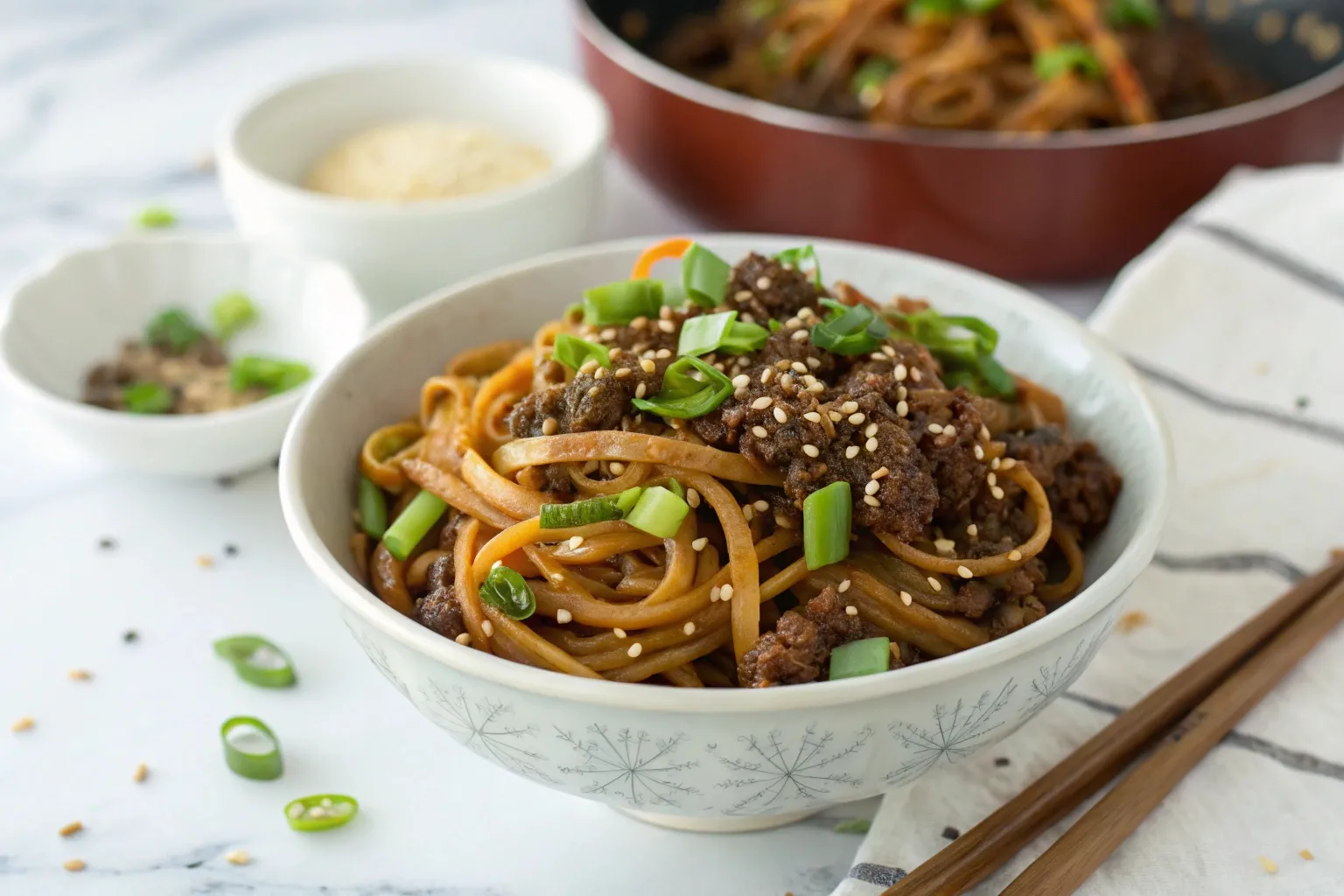Mongolian ground beef noodles are a flavor-packed, quick, and satisfying dish that’s perfect for busy weeknights. Combining tender noodles, savory ground beef, and a sweet and spicy sauce, this recipe brings the best of Asian-inspired cuisine to your table. In this guide, you’ll discover everything from ingredients to preparation tips, along with variations and serving ideas to customize the dish to your liking. Let’s dive in!
Introduction to Mongolian Ground Beef Noodles
What Are Mongolian Ground Beef Noodles?
Mongolian ground beef noodles are a twist on the classic Mongolian beef recipe. While the original dish features thinly sliced beef, this version uses ground beef for a quicker and more budget-friendly option. Paired with soft, slurpable noodles and a rich sauce, it’s an irresistible combination of sweet, savory, and umami flavors.
The dish’s simplicity is its charm, making it a go-to meal for home cooks worldwide. Whether you’re craving comfort food or need a quick dinner idea, Mongolian ground beef noodles deliver on all fronts.
Why This Dish Is Popular
Why has this recipe gained so much love? It’s versatile, easy to make, and doesn’t require fancy ingredients. You can whip it up in under 30 minutes using pantry staples like soy sauce, garlic, and noodles. Plus, the balance of flavors—sweet brown sugar, salty soy sauce, and zesty ginger—creates a dish that feels indulgent without being overly complicated.
Cultural Significance and Inspiration
Although inspired by Chinese and Mongolian flavors, the dish is an Americanized creation designed for convenience. Its appeal lies in its ability to adapt to different cuisines while maintaining a distinct Asian-inspired taste. By using ingredients like hoisin sauce, beef broth, and ground ginger, you can create a dish that nods to its roots while being uniquely customizable.
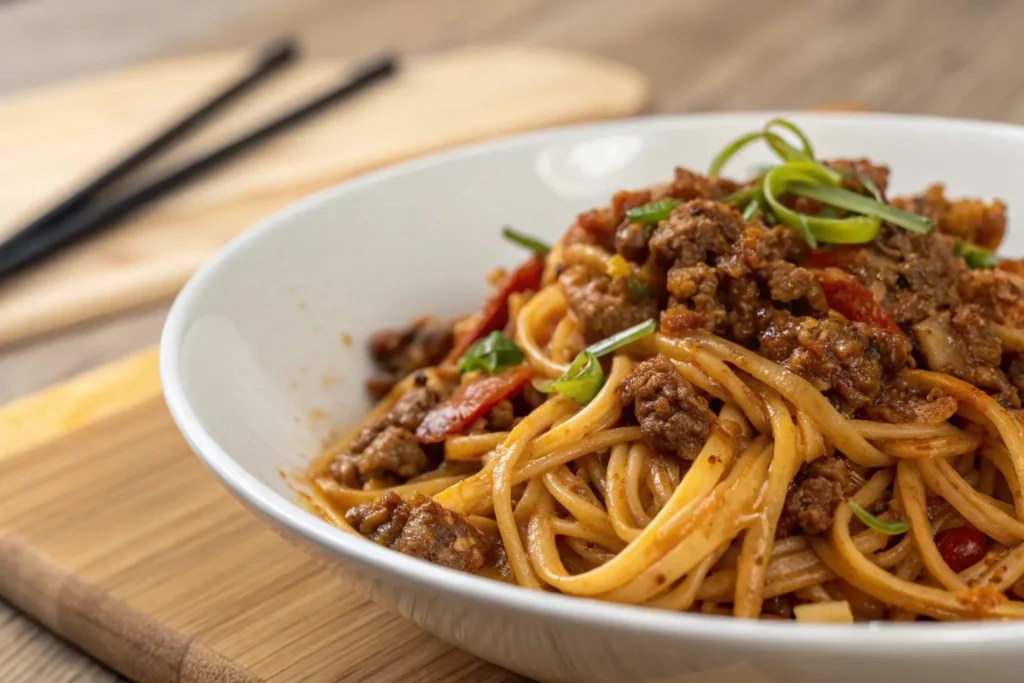
Ingredients Overview
Essential Ingredients for Mongolian Ground Beef Noodles
To craft the perfect Mongolian ground beef noodles, you’ll need a handful of staples that balance sweet, salty, and savory flavors. Here’s what you’ll need:
- Ground Beef: The star of the dish. Opt for lean beef to avoid excess grease.
- Noodles: Lo mein, spaghetti, or even rice noodles work well.
- Soy Sauce: Brings the signature salty and umami flavor.
- Hoisin Sauce: Adds sweetness and depth to the sauce.
- Brown Sugar: Enhances the sweet undertones.
- Garlic and Ginger: Provide a zesty kick and aromatic profile.
- Beef Broth: Helps to create a rich and slightly saucy consistency.
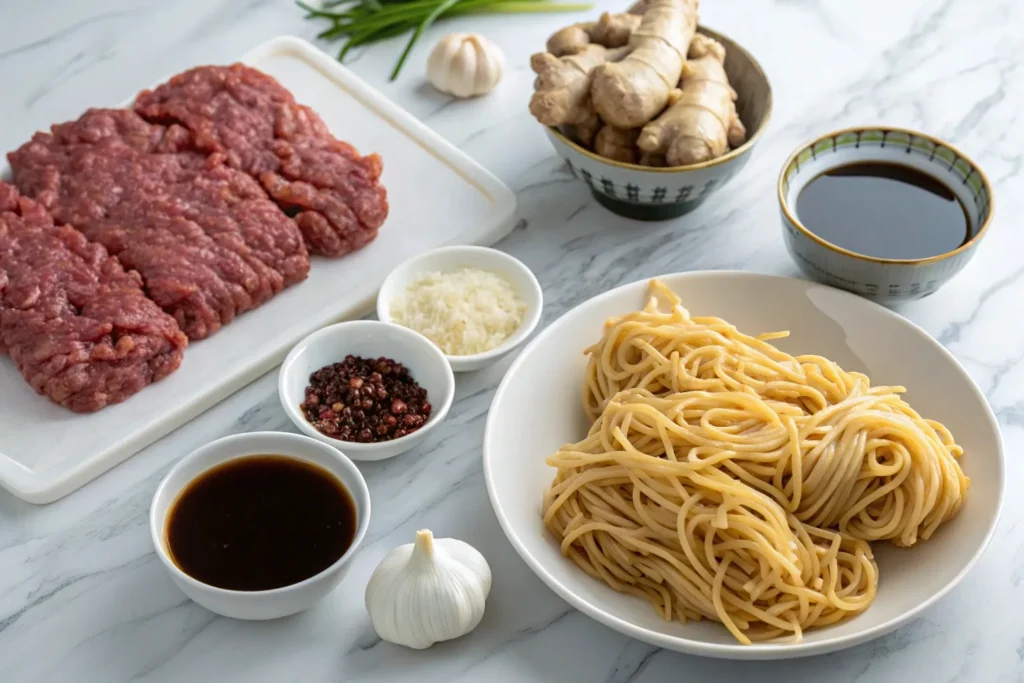
Substitutions and Variations
If you’re missing an ingredient or prefer alternatives, there’s plenty of room for customization.
- Replace ground beef with ground turkey or chicken for a lighter version.
- Gluten-free? Swap soy sauce for tamari and choose rice noodles.
- Add a splash of sesame oil for a nutty flavor twist.
Understanding the Sauce: Soy Sauce, Hoisin, and Ginger
The sauce is where the magic happens. A blend of soy sauce and hoisin sauce creates a savory-sweet foundation, while garlic and ginger add warmth and spice. It’s a harmonious balance that elevates the noodles and beef.
For those looking for similar dishes, check out Italian drunken noodles for another noodle recipe with bold flavors.
Step-by-Step Cooking Instructions for Mongolian ground beef noodles
Preparing the Noodles
The foundation of your Mongolian ground beef noodles is perfectly cooked noodles. Start by selecting the type of noodle that best fits your taste and dietary needs—lo mein, spaghetti, or rice noodles are all excellent choices. Bring a pot of water to a boil and add a pinch of salt for flavor. Cook the noodles according to the package instructions, ensuring they are slightly undercooked (al dente). This is essential because the noodles will continue to cook when combined with the sauce later.
Once the noodles are ready, drain them thoroughly and rinse under cold water to stop the cooking process. Toss the noodles with a small drizzle of sesame oil or olive oil to keep them from sticking. This also adds a subtle layer of flavor that pairs beautifully with the dish. Set the noodles aside while you prepare the other components.
Cooking the Ground Beef
Heat a large skillet or wok over medium heat and add a splash of vegetable oil. Once the oil is hot, add the ground beef and begin breaking it into smaller pieces using a wooden spoon or spatula. As the beef cooks, season it lightly with salt and pepper to build flavor from the start.
Cook the ground beef until it is browned and no longer pink, which should take about 5-7 minutes. For a leaner dish, carefully drain any excess grease from the skillet. However, leaving a small amount of fat in the pan enhances the flavor of the sauce. Once the beef is fully cooked, remove it from the skillet and set it aside temporarily.
Combining Flavors for the Perfect Sauce
Now it’s time to make the sauce—the heart of Mongolian ground beef noodles. In the same skillet, add minced garlic and freshly grated ginger. Sauté them for 1-2 minutes until they become fragrant. This step creates a flavorful base that will infuse the entire dish.
Next, pour in soy sauce, hoisin sauce, and a small amount of beef broth. Add brown sugar to balance the saltiness of the soy sauce with a touch of sweetness. Stir the mixture well and let it simmer for 3-4 minutes until the sauce begins to thicken slightly. If you prefer a spicier dish, now is the time to add red chili flakes or sriracha.
To enhance the sauce’s depth of flavor, consider adding a splash of rice vinegar or a drizzle of sesame oil. These ingredients add complexity and help tie all the flavors together.
Assembling the Dish
Return the cooked ground beef to the skillet and mix it into the sauce, ensuring every piece is coated. Then, add the prepared noodles and toss everything together. Use tongs or a large spoon to combine the ingredients evenly.
Cook the mixture for an additional 2-3 minutes, allowing the noodles to absorb the sauce fully. This step ensures every bite of your Mongolian ground beef noodles is packed with flavor. For added freshness, sprinkle chopped green onions and sesame seeds on top just before serving.
Bonus Cooking Tip
If you want to incorporate vegetables into your dish, this is the perfect moment. Add thinly sliced bell peppers, shredded carrots, or snap peas to the skillet when you combine the beef with the sauce. Cook the vegetables until they’re tender but still slightly crisp, which adds a delightful texture contrast to the dish.
With these detailed steps, you’ll create a batch of Mongolian ground beef noodles that’s both visually appealing and incredibly delicious. Whether you’re cooking for your family or impressing guests, this recipe is sure to be a hit!
Tips and Tricks for the Best Results for Mongolian ground beef noodles
Getting the Texture Right
The texture of your Mongolian ground beef noodles plays a crucial role in the dish’s overall appeal. To ensure tender beef, avoid overcooking it. Use medium heat and stir frequently to break the meat into small, even pieces. For the noodles, slightly undercook them during boiling since they’ll absorb more flavor when tossed with the sauce.
Adjusting Spice Levels to Your Taste
Whether you love a little heat or prefer it mild, this dish is easily adjustable. Add red chili flakes or a splash of sriracha if you’re craving more spice. On the other hand, for a milder version, skip the heat entirely and let the sweet-savory sauce shine.
Making It Ahead of Time
Need a quick meal solution? Prepare the sauce and cook the ground beef in advance. Store them separately in airtight containers in the fridge for up to three days. When you’re ready to eat, boil the noodles fresh, reheat the sauce and beef, and toss them together.
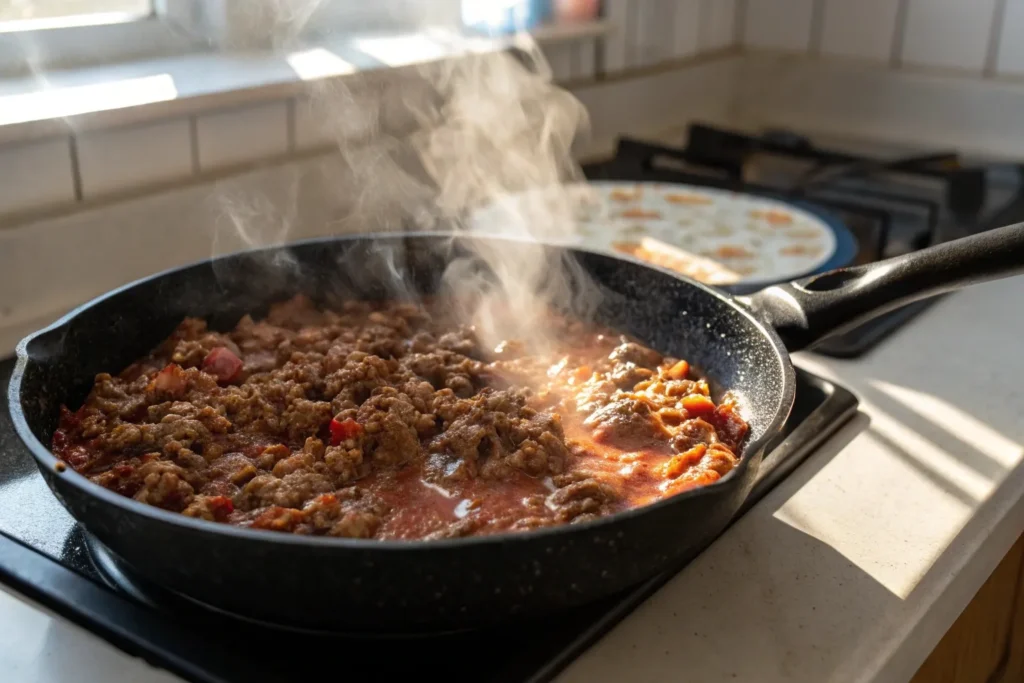
Variations of Mongolian Ground Beef Noodles
Vegetarian and Vegan Alternatives
You can make Mongolian ground beef noodles vegetarian by replacing ground beef with plant-based protein like crumbled tofu or tempeh. For a vegan twist, ensure all sauces (e.g., hoisin) are plant-based and swap honey for maple syrup, if used.
Gluten-Free Options
For those avoiding gluten, choose rice noodles or other gluten-free alternatives like zucchini noodles. Additionally, replace soy sauce with tamari or coconut aminos to keep the dish gluten-free without sacrificing flavor.
Adding Vegetables for a Healthier Twist
Elevate your Mongolian ground beef noodles by incorporating vegetables. Thinly sliced bell peppers, julienned carrots, or snap peas add a refreshing crunch and balance the richness of the beef. Toss them in during the last few minutes of cooking for perfectly tender veggies.
For more recipe inspiration, don’t miss our Simple Asian Recipes, where you’ll find a variety of dishes to complement your meal.
Would you like to continue with Part 6: Pairing Suggestions and Serving Ideas?
Pairing Suggestions and Serving Ideas
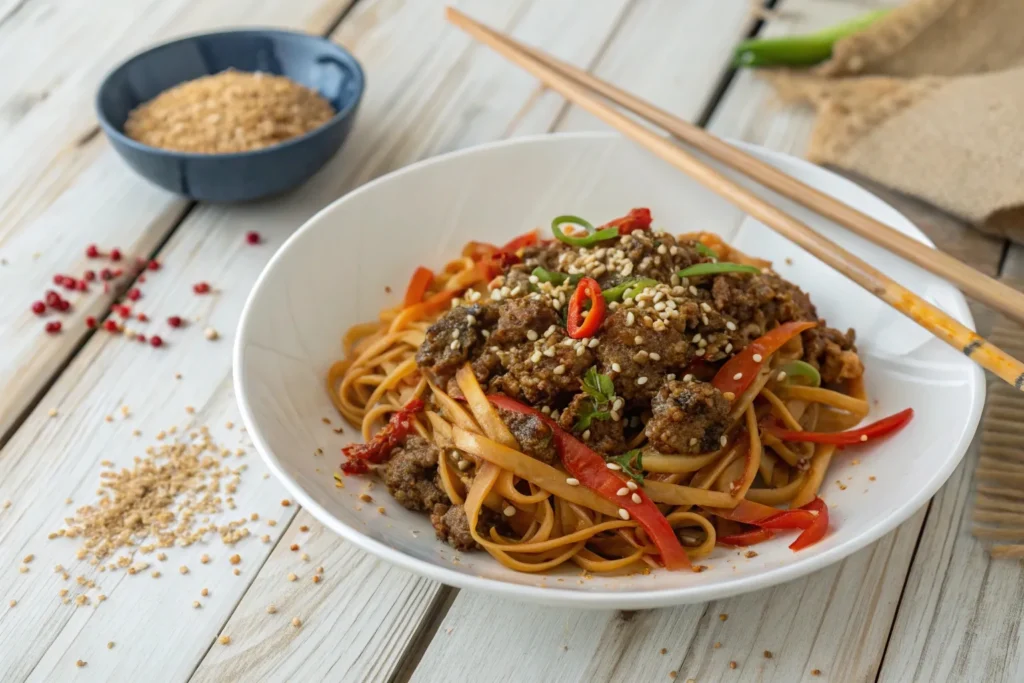
What to Serve With Mongolian Ground Beef Noodles
Mongolian ground beef noodles are a hearty, flavorful dish, but pairing them with complementary sides can take your meal to the next level. A crisp Asian slaw or steamed vegetables like broccoli or bok choy add texture and balance to the rich sauce. For a more indulgent spread, serve with crispy spring rolls or dumplings for an appetizer.
Another great pairing is a light, refreshing salad with sesame dressing, which offsets the bold flavors of the noodles. If you’re feeling adventurous, try a side of miso soup for a comforting, restaurant-style meal.
Drinks That Complement the Dish
When it comes to drinks, the slightly sweet and savory flavors of Mongolian ground beef noodles pair beautifully with a variety of beverages. Green tea or jasmine tea works well, cleansing the palate between bites. For those who enjoy wine, a dry Riesling or light Pinot Noir enhances the dish’s complexity without overwhelming it. Non-alcoholic options like sparkling water with lime or a fruity iced tea also pair wonderfully.
Plating Ideas for Presentation
Presentation matters, even for weeknight meals. Serve your Mongolian ground beef noodles in a shallow bowl or large plate, twirling the noodles into a neat mound. Sprinkle sesame seeds and chopped green onions on top for a pop of color and garnish with a wedge of lime for a zesty finishing touch. These small details make the dish look as delicious as it tastes!
Nutritional Information for Mongolian Ground Beef Noodles
Here’s a breakdown of the nutritional content for Mongolian ground beef noodles (per 100g):
Nutritional Content
| Nutrient | Amount (per 100g) |
|---|---|
| Calories | 215 kcal |
| Protein | 9 g |
| Fat | 10 g |
| Carbohydrates | 22 g |
| Sugar | 4 g |
| Fiber | 1 g |
| Sodium | 620 mg |
Frequently Asked Questions (FAQs)
Can I Use a Different Type of Noodle?
Absolutely! While traditional recipes use lo mein or spaghetti, you can experiment with rice noodles, soba, or even zucchini noodles for a low-carb option. Just ensure the noodle you choose complements the rich sauce.
How Do I Store Leftovers?
Leftovers of Mongolian ground beef noodles can be stored in an airtight container in the refrigerator for up to three days. To reheat, simply microwave them in 30-second intervals, stirring in between to evenly warm them. Add a splash of beef broth or water to loosen the sauce if it thickens.
Can I Make This Recipe Spicier?
Yes, and it’s easy to adjust the heat level. Add red pepper flakes, sriracha, or even a dash of chili oil to the sauce. Start small and taste as you go to avoid overpowering the other flavors.
What Are Some Common Mistakes to Avoid?
Avoid overcooking the noodles, as they can turn mushy when tossed with the sauce. Also, don’t skip the step of browning the ground beef thoroughly—it enhances the flavor of the entire dish. Finally, taste the sauce before serving and adjust the balance of sweet, salty, and spicy as needed.
Would you like to proceed to the conclusion and final thoughts?
Conclusion and Final Thoughts
Why You Should Try Mongolian Ground Beef Noodles Today
If you’re searching for a dish that’s easy to prepare yet bursting with flavor, Mongolian ground beef noodles should be at the top of your list. With its quick cooking time, budget-friendly ingredients, and customizable nature, this dish is perfect for any occasion—whether it’s a weeknight dinner or a meal to impress friends.
The balance of sweet, savory, and spicy flavors in the sauce creates a satisfying meal that pairs beautifully with a variety of sides and drinks. Plus, the versatility of this recipe means you can adapt it to suit your dietary preferences, making it a must-have in your meal rotation.
Encouragement to Experiment with Flavors
Cooking is all about making recipes your own, and Mongolian ground beef noodles offer the perfect canvas for creativity. Don’t hesitate to try new ingredients, like adding fresh herbs, swapping proteins, or experimenting with noodles. The more you make this dish, the more you’ll discover ways to tailor it to your taste.
Related Recipes to Explore
Explore More Asian-Inspired Dishes
Now that you’ve mastered Mongolian ground beef noodles, why not expand your repertoire? Dishes like stir-fried rice, sweet-and-sour chicken, or teriyaki salmon share similar bold flavors and are just as easy to prepare.
For more inspiration, check out our Simple Asian Recipes for dishes that bring global flavors right to your kitchen. Whether you’re craving something light, hearty, or adventurous, there’s always something new to try.
Why Variety Matters in Your Meal Planning
Adding variety to your meals not only keeps things interesting but also helps you explore new cuisines and ingredients. From noodle dishes to soups and everything in between, incorporating diverse recipes into your routine can make cooking more enjoyable and rewarding.

